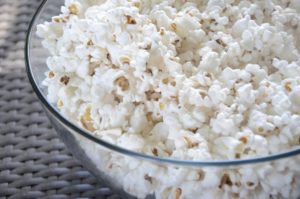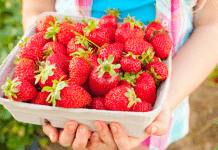As much as I despise driving home from work in the dark, the Plaza lights are a welcome consolation. Visiting the Plaza and enjoying the spectacle is a tradition for all of us who call KC home, and a brilliant display of the Holiday season. I am thankful to live in such a vibrant and dynamic place, and especially grateful for another healthy and happy year for those I love and those I care for.
As we grab our families and gather together to share in celebration, my wish is that everyone does so safely. Without trying to be a Grinch, I feel it is important to share the fact that accidental injuries do increase over the Holidays. Specifically, there have been frequent reports of aspiration and choking during December. Travel to new places, festive Holiday foods, and less supervision of kids during busy get-togethers all contribute to this rise.
For this Holiday season – and the whole year through – here are 5 essential things to know about kids and choking.
1. It’s not just grapes and hot dogs. The most common cause of choking in children is food items. The most common culprits are:
- Popcorn. S
 eeing preschoolers eating popcorn gives me the anxiety sweats. The trouble with popcorn is that small soft pieces or hulls of the corn can be inhaled, causing the windpipe to spasm. This spasm cannot be reversed with the Heimlich maneuver, and kids lose oxygen to their brain. Avoid popcorn, or offer with strictest of supervision, until the age of 4 years.
eeing preschoolers eating popcorn gives me the anxiety sweats. The trouble with popcorn is that small soft pieces or hulls of the corn can be inhaled, causing the windpipe to spasm. This spasm cannot be reversed with the Heimlich maneuver, and kids lose oxygen to their brain. Avoid popcorn, or offer with strictest of supervision, until the age of 4 years. - Nuts/seeds. These small pieces can go down the wrong pipe and be very difficult to dislodge. No child should have nuts until he or she can spell “N-U-T-S.”
- Grapes. Most parents happily cut up grapes for first finger foods but forget that a child’s windpipe is still small until the age of 4. Until that age, keep cutting your grapes lengthwise and into quarters to avoid offering any round pieces of the fruit.
- Marshmallows. ‘Mallows get squishy and slippery when gummed by a toddler. Choose another sweet treat instead.
- Gum/hard candy. Like marshmallows, gum is hard to control in the mouth and can cause gagging and choking in young kids. Hard candies can injure by slipping into the airway.
- Big chunks of hard vegetables or fruit. Think about the size of a Cheerio. That is a good approximation of a safe size. Smaller is safer.
- Big chunks of peanut butter. PB is really, really sticky. A big glob of the stuff in a preschooler’s mouth can be difficult to manipulate and easily get lodged. Best to offer a thin layer of PB on breads and crackers.
- Hot dogs. I cut my kids’ hot dogs lengthwise twice (making 4 long strips) until they were in kindergarten. Just sayin’.
2. Ornaments are shiny. Beautiful decorations are hypnotic to kids, especially the teeny, tiny sparkly stuff. Kids also love to explore shiny things by putting them into their mouths. If you are visiting a home that does not have any small people living in it, be mindful to watch your toddler closely around holiday decor.
3. Uncle Bob has not been around small kids in a while. When your toddler wants to try Uncle Bob’s popcorn, he will most likely be happy to share. To avoid trouble, if you see high-risk snacks being passed around at the party, consider reminding Uncle Bob that your kids prefer a different snack or that popcorn gives them explosive diarrhea. (Wink.) Either way, he should get the hint. And be sure that all the Holiday gifts are age appropriate, too. If a toy piece can fit through a toilet paper tube, then it’s too small for a toddler.
 4. Sit and eat. Your mom made you sit at the table for a reason! Kids are at an increased risk of choking when they have food in their mouths and are running around. One gasp for air or trip in their step and nearly anything can fall down the wrong pipe. So, teach kids from an early age that they must sit to eat. And here’s a secret… most pediatricians and ER docs don’t let their kids eat in the car or in the stroller. We are not afraid of messes, we fear choking.
4. Sit and eat. Your mom made you sit at the table for a reason! Kids are at an increased risk of choking when they have food in their mouths and are running around. One gasp for air or trip in their step and nearly anything can fall down the wrong pipe. So, teach kids from an early age that they must sit to eat. And here’s a secret… most pediatricians and ER docs don’t let their kids eat in the car or in the stroller. We are not afraid of messes, we fear choking.
5. Know your stuff. Every five days, one child in the US dies of choking. Really. Would you know what to do if you saw a person choking? I’d love for all my families to be current adult and child CPR by taking a local class. In a pinch, however, many health systems have some great YouTube videos that can teach you how to help. Take a minute to watch, it just might help you save a life.
Enjoy each other. Be intentional. Stop to remember. Drive sober. Refrigerate leftovers. Wear your helmet. Sleep in. Buckle up. Play with your kids. Create new memories. Wash your hands. Be safe. And, it’s not too late to get a flu shot!
Wishing all of KC the best and brightest of the Season, and a healthy and happy New Year!
 Dr. Natasha Burgert is a Kansas City mom, pediatrician, writer, educator, and National Spokesperson for the American Academy of Pediatrics. She is a routine contributor to NBC’s Parent Tool Kit, the US News and World Report parenting blog, and our local KCUR. She also represents Kansas City on the State of Missouri Advisory Committee on Childhood Immunizations. If you can’t catch her between patients at Pediatric Associates, find her on Instagram, Facebook, and Twitter.
Dr. Natasha Burgert is a Kansas City mom, pediatrician, writer, educator, and National Spokesperson for the American Academy of Pediatrics. She is a routine contributor to NBC’s Parent Tool Kit, the US News and World Report parenting blog, and our local KCUR. She also represents Kansas City on the State of Missouri Advisory Committee on Childhood Immunizations. If you can’t catch her between patients at Pediatric Associates, find her on Instagram, Facebook, and Twitter.

















Thank you! As a mom of two, this is very helpful info.